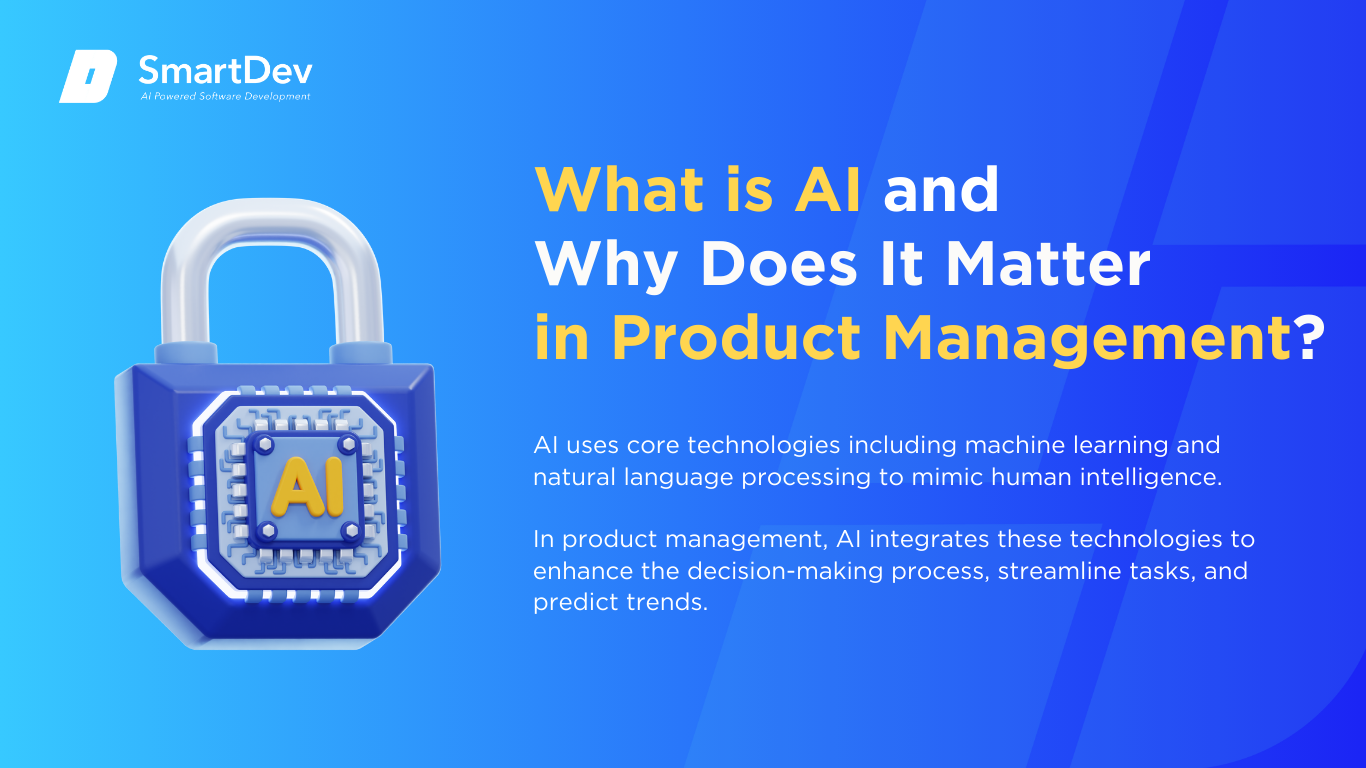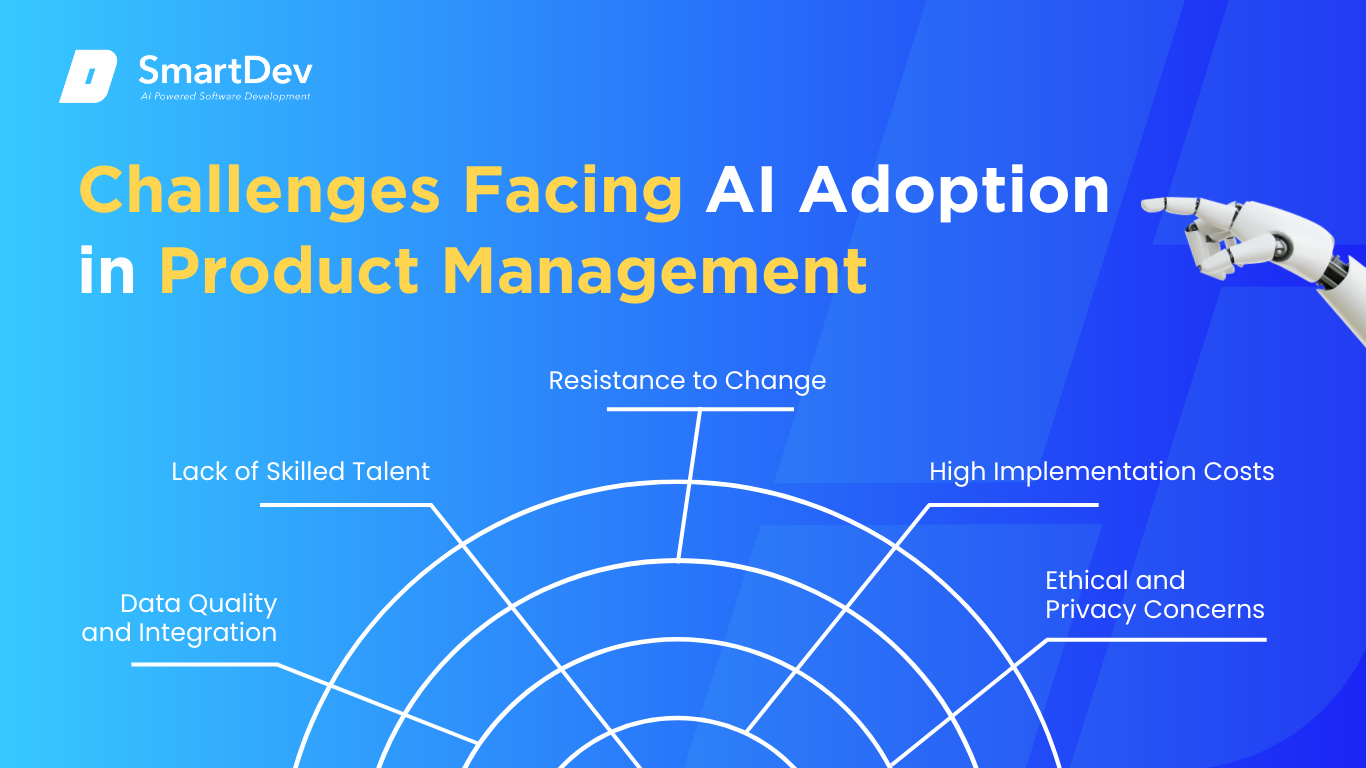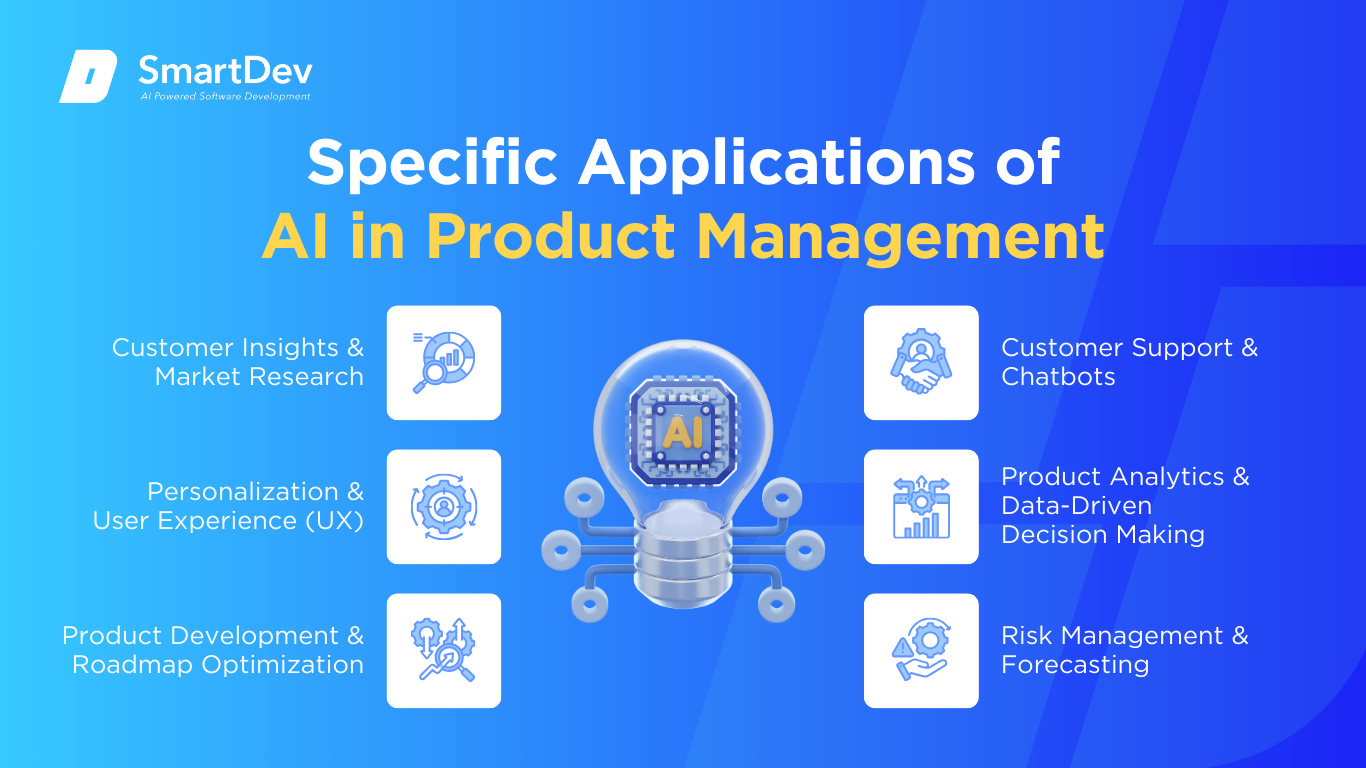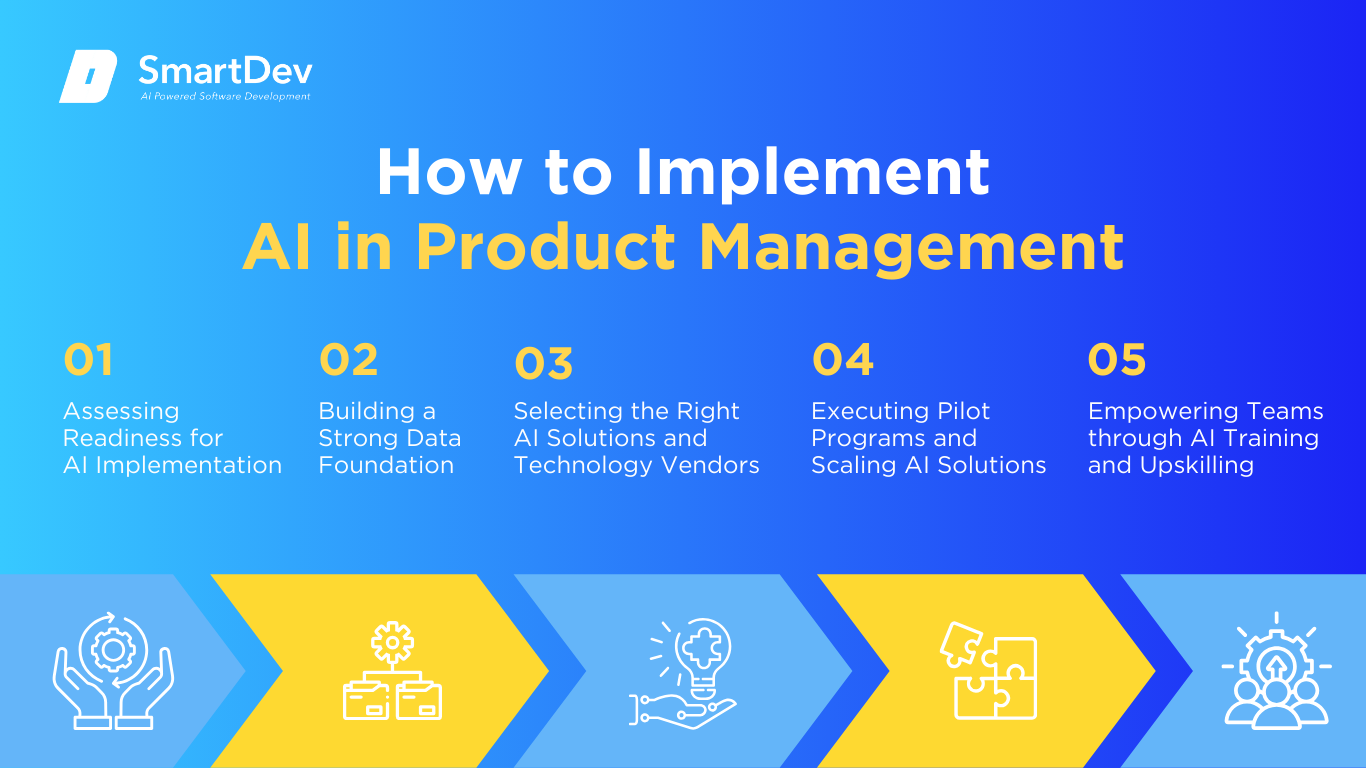Introduction
Product management is rapidly evolving as businesses face increasing pressure to innovate and meet changing customer demands. AI in product management is transforming the industry by automating tasks, improving decision-making, and delivering valuable customer insights. This guide explores key AI use cases, benefits, and strategies for implementing AI in product management to stay competitive and drive growth.
What is AI and Why Does It Matter in Product Management?

Definition of AI and Its Core Technologies
Artificial Intelligence (AI) refers to the simulation of human intelligence processes by machines, particularly computer systems. These processes include learning (from data), reasoning (for decision-making), and self-correction. AI technologies like machine learning, natural language processing (NLP), and computer vision enable machines to analyze patterns, understand language, and even interpret images or video, making them highly versatile in a variety of applications.
In product management, AI integrates these technologies to enhance the decision-making process, streamline tasks, and predict trends. For example, machine learning can help forecast market demand or user preferences, while NLP can automate customer feedback analysis, helping product teams make data-driven decisions faster.
To frame how AI flows from data to deployment in product contexts, our AI development life cycle guide breaks down stages, risks, and checkpoints.
The Growing Role of AI in Transforming Product Management
AI is playing an increasingly vital role in transforming product management by enhancing data-driven decision-making. With access to vast amounts of customer and market data, AI tools can quickly identify trends, preferences, and potential opportunities. This enables product managers to make more informed, accurate decisions that align with customer needs and market demands.
Moreover, AI helps streamline product development by automating repetitive tasks and providing real-time performance insights. By using AI-powered tools, product teams can track progress, identify bottlenecks, and allocate resources more efficiently. This not only speeds up the product development cycle but also improves overall team productivity.
As AI continues to evolve, its integration into product management will drive greater innovation. Predictive analytics, machine learning, and natural language processing can all be leveraged to create more personalized products and anticipate customer needs. With AI, product managers can stay ahead of trends, identify emerging opportunities, and deliver products that meet or exceed customer expectations.
Key Statistics and Trends Highlighting AI Adoption in Product Management
AI adoption in product management is accelerating, with 65% of organizations regularly using generative AI in at least one business function, nearly doubling from the previous year. This widespread integration underscores AI’s growing role in enhancing efficiency and innovation within product teams.
The impact of AI is evident in its ability to streamline product development processes. A survey by Bain & Company found that 76% of executives reported AI shortened the time to market for new products, highlighting its value in accelerating product delivery.
Looking ahead, the AI market is poised for significant growth. According to Statista, the AI industry is expected to grow at a compound annual growth rate (CAGR) of 27.67% over the next five years, reaching a market volume of $826.73 billion by 2030. This expansion reflects the increasing investment in AI technologies across industries, including product management.
Business Benefits of AI in Product Management
AI is transforming product management by solving key challenges and driving significant business value. From improving decision-making to optimizing resources, AI empowers product managers to innovate and streamline operations, leading to better outcomes.

1. Enhanced Decision-Making
AI enables more informed decision-making by providing accurate insights from large data sets. Predictive analytics help product managers forecast trends and user behavior, ensuring decisions align with business objectives. This data-driven approach reduces uncertainty and supports smarter strategic choices.
Moreover, AI identifies potential risks and opportunities by recognizing patterns in historical data. This proactive capability allows product managers to adjust strategies before issues arise, ensuring the product remains competitive and aligned with market demands.
2. Streamlined Product Development
AI automates routine tasks such as resource allocation and progress tracking, boosting team efficiency. This allows product managers to focus on higher-value activities, speeding up the product development cycle. By streamlining administrative processes, AI accelerates time-to-market for new features and products.
AI-powered real-time tracking also identifies bottlenecks, allowing teams to make adjustments on the fly. With this visibility, product managers can optimize workflows and reallocate resources where needed, ensuring smoother development processes and faster delivery.
To examine modernization patterns that lift delivery velocity, this case on transforming legacy systems and enhancing delivery efficiency details the before-and-after.
3. Improved Customer Insights
AI delivers deep insights into customer behavior by analyzing data from multiple sources. This helps product managers understand customer preferences and pain points, leading to more relevant product decisions. As a result, AI ensures products are better aligned with market needs, improving customer satisfaction.
Additionally, AI enables personalized experiences by tailoring recommendations and features to individual users. This customization increases engagement and retention, as customers feel their needs are specifically addressed, fostering long-term loyalty.
4. Optimized Resource Allocation
AI optimizes resource allocation by analyzing past data to predict where efforts will yield the most impact. This helps product managers allocate teams, budgets, and time more effectively, ensuring high-priority projects are well-resourced. With AI, resource use is maximized, and strategic objectives are met efficiently.
Real-time tracking also ensures resources are continually adjusted based on current needs. This adaptability allows product managers to respond to changing conditions quickly, ensuring that projects stay on schedule and within budget.
5. Increased Product Innovation
AI accelerates innovation by uncovering market gaps and emerging trends through data analysis. It helps product teams identify new opportunities for features or products that align with customer demand, keeping the product competitive. This ability to spot unmet needs drives faster, more impactful innovation.
AI also aids rapid prototyping and testing by simulating different product iterations and analyzing user feedback. This shortens the feedback loop, allowing product managers to refine and launch products more quickly, ensuring they remain responsive to customer expectations.
Challenges Facing AI Adoption in Product Management
While AI offers tremendous potential, its adoption comes with several challenges. From data integration issues to talent shortages, product managers must overcome these hurdles to fully capitalize on AI’s capabilities and ensure its successful implementation.

1. Data Quality and Integration
AI’s effectiveness relies on access to clean, high-quality data, yet many product teams struggle with fragmented or inconsistent data. Without accurate, centralized data, AI models may produce unreliable insights or fail to generate value. Ensuring data quality and integration across various platforms is a significant hurdle that product managers must address before fully leveraging AI.
Additionally, integrating AI tools into existing systems can be complex, particularly when dealing with legacy infrastructure. Product teams must invest time and resources into ensuring smooth integration, which can slow down AI adoption and limit its potential if not done effectively.
To learn how unstructured data can be effectively leveraged in AI applications, check out our detailed guide on how AI unlocks the power of unstructured data.
2. Lack of Skilled Talent
To fully harness AI, product managers need a combination of technical and strategic skills. However, the shortage of AI talent is a major challenge, as many product teams lack the expertise required to develop, implement, and maintain AI solutions. This skills gap may hinder AI adoption or lead to underutilization of the technology.
Moreover, upskilling existing teams can be a costly and time-consuming process. Organizations may need to invest in training or hire specialized AI professionals to fill this gap, adding to the overall cost and complexity of AI implementation in product management.
3. Resistance to Change
AI adoption often faces resistance from teams who are accustomed to traditional workflows. Product managers may encounter reluctance to trust AI-driven recommendations or fear that automation will reduce their roles. Overcoming this cultural resistance requires effective communication, change management, and clear demonstrations of AI’s value.
This resistance can delay AI implementation, as teams may be slow to embrace new tools or adjust their processes. Building confidence in AI’s capabilities and ensuring that it complements human decision-making, rather than replacing it, is essential for smooth adoption.
To illustrate incremental AI adoption inside an existing product, our case study on AI-Driven Media Engagement Platform for a Leading Journalism and PR Marketplace shows targeted AI features rolled out without disruption.
4. High Implementation Costs
The upfront investment required for AI tools and infrastructure can be a significant barrier, especially for smaller teams or organizations with limited budgets. Implementing AI in product management involves costs related to software, hardware, training, and integration, which may not be immediately offset by tangible results. This can make it difficult for organizations to justify the investment, especially in the early stages.
Additionally, ongoing maintenance and updates for AI systems add to the long-term costs. These expenses must be carefully weighed against the expected benefits, and product managers must be prepared for the financial commitment required to adopt AI at scale.
5. Ethical and Privacy Concerns
AI often requires access to large amounts of user data, raising concerns around privacy and ethical usage. Product managers must navigate regulations such as GDPR to ensure compliance and protect user data. Failure to do so could result in legal penalties and damage to the company’s reputation.
Furthermore, biases in AI algorithms can lead to unfair or discriminatory outcomes, particularly when the data used to train the models is flawed. Ensuring that AI models are transparent, ethical, and free from bias is crucial to maintaining trust with customers and stakeholders.
Explore how ethical and explainability concerns are addressed in real-world deployments in our detailed guide on AI ethics concerns.
Specific Applications of AI in Product Management

1. Customer Insights and Market Research
AI-powered tools are transforming market research by enabling product managers to analyze vast amounts of unstructured data, such as customer reviews, social media conversations, and surveys. Through sentiment analysis and predictive analytics, AI helps businesses identify customer sentiment, predict market shifts, and stay ahead of trends. By continuously processing and analyzing customer feedback, AI tools allow product teams to make faster, data-driven decisions and refine their products to meet customer needs more effectively.
AI also streamlines competitor analysis by monitoring competitors’ product offerings, marketing strategies, and customer feedback in real time. This enables product managers to spot competitive gaps and new opportunities for differentiation. With these insights, companies can adjust their strategies and product roadmaps, ensuring they remain competitive in the market.
By leveraging AI in market research, businesses can quickly adapt to changes in customer preferences and market dynamics, all while making more informed product decisions. This leads to faster product iterations and a more responsive approach to customer needs.
Real‑World Example:
Brandwatch uses AI to analyze consumer sentiment on social media platforms. Companies like Coca-Cola and Sony rely on Brandwatch to track conversations about their brands and understand customer attitudes.
2. Personalization and User Experience (UX)
AI plays a critical role in personalizing user experiences by analyzing individual behaviors, preferences, and interactions with a product. By offering personalized recommendations or dynamically adjusting the content and layout of a product, AI enhances user satisfaction and engagement. As users interact more with the product, AI refines its recommendations, making the experience increasingly tailored and relevant, which boosts user retention and loyalty.
AI can also improve user interfaces (UI) by adapting them to the specific needs and behaviors of individual users. These dynamic UI adjustments ensure that users are presented with the most relevant features, content, and functionality, making the product more intuitive and user-friendly. Over time, as AI continues to learn from user interactions, the product experience becomes increasingly personalized, ensuring users stay engaged longer.
Behavioral segmentation powered by AI allows product managers to target specific groups of users with personalized messaging or features. This targeted approach improves conversion rates and fosters deeper engagement with users, driving greater satisfaction and retention.
Real‑World Example:
Netflix uses AI to provide personalized content recommendations based on users’ viewing history and preferences. According to McKinsey, more than 80% of content viewed on Netflix comes from these AI-driven recommendations, contributing to a more engaged and loyal user base.
To compare another pattern for individualized comms, our case study on Next-Gen Countdown App: New Dimensions in Communication Powered by AI demonstrates scalable generative UX.
3. Product Development and Roadmap Optimization
AI enhances product development by helping product managers prioritize features based on user feedback, market trends, and business goals. By analyzing historical data and identifying key patterns, AI provides valuable insights into which features will likely provide the most value to users. This data-driven approach allows product managers to align their product roadmaps with customer demand and ensure they’re investing resources in the most impactful areas.
AI also streamlines product development workflows by automating repetitive tasks such as tracking project milestones and coordinating cross-functional teams. This reduces administrative overhead and minimizes the risk of errors, allowing teams to focus more on innovation and strategic decision-making. By automating routine tasks, AI accelerates the development process and fosters greater collaboration across teams.
In addition, AI enhances A/B testing by quickly analyzing results and providing actionable insights. This speeds up decision-making and enables product managers to make informed changes faster, ensuring continuous improvement in product performance.
Real‑World Example:
Productboard helps companies like Zoom optimize their product roadmaps by integrating AI to analyze user feedback and prioritize features. Productboard’s AI-powered platform enables Zoom to focus development on the most valuable features for users, improving product decisions.
4. Customer Support and Chatbots
AI-driven chatbots are revolutionizing customer support by offering instant responses to frequently asked questions and simple queries. These bots can handle a large volume of customer inquiries simultaneously, providing 24/7 support without burdening human agents. This reduces response times and ensures that customers receive prompt assistance whenever they need it.
With natural language processing (NLP), AI chatbots can also handle more complex customer queries, escalating them to human agents only when necessary. Over time, as the chatbot learns from past interactions, it becomes more efficient at understanding and addressing customer issues. This helps improve the overall customer experience while also freeing up human agents to handle more intricate problems.
Predictive AI tools take customer support a step further by anticipating issues before they arise. By analyzing historical data, these tools can predict when a customer might face an issue or need help, allowing businesses to address problems proactively and reduce churn.
Real‑World Example:
Zendesk uses AI-powered chatbots to help businesses like Shopify automate customer support. These chatbots assist in responding to customer inquiries, reducing wait times, and improving satisfaction. According to a recent case study on Shopify-Zendesk integrations, AI-powered e-commerce support tools have reduced response times by up to 50%.
5. Product Analytics and Data-Driven Decision Making
AI-driven product analytics tools help product managers gather deep insights into how users engage with a product. By tracking user behavior, AI can identify areas where users are dropping off, struggling with features, or failing to adopt key functionalities. This data allows teams to quickly make improvements and enhance the user experience.
In addition, predictive analytics can forecast future user behavior, helping product managers plan for potential challenges such as user churn or feature adoption. These insights enable teams to take proactive actions to improve retention, optimize features, and align their product strategy with customer needs.
AI-powered tools also enhance decision-making by automating the analysis of large data sets, uncovering trends and insights that may be difficult to detect through manual analysis. This allows product managers to make faster, more informed decisions that drive product success.
Real‑World Example:
Mixpanel helps companies like Uber and Airbnb analyze user behavior and optimize their product offerings. According to Mixpanel, their analytics helped Kast improve user retention by 50%.
6. Risk Management and Forecasting
AI helps product managers improve forecasting accuracy by predicting demand, sales trends, and potential market disruptions. Machine learning models analyze past data and external factors to make more precise forecasts, which helps product managers plan resources, set pricing strategies, and optimize inventory management.
AI also aids in detecting early signs of risks, such as supply chain disruptions or shifts in customer sentiment. By continuously monitoring data, AI can identify potential problems before they escalate, allowing businesses to act proactively and avoid negative impacts on product performance.
Furthermore, AI enhances supply chain management by forecasting potential bottlenecks and recommending alternative strategies to avoid delays. This ensures smoother operations and helps businesses meet customer demand without interruptions.
Real‑World Example:
deepsense.ai uses AI to predict potential equipment failures in hospitals, helping them reduce downtime and improve operational efficiency. According to their case study, their AI-powered platform has helped prevent up to 30% of device failures.
Need Expert Help Turning Ideas Into Scalable Products?
Partner with SmartDev to accelerate your software development journey — from MVPs to enterprise systems.
Book a free consultation with our tech experts today.
Let’s Build TogetherExamples of AI in Product Management
AI is transforming product management, with real-world applications delivering significant results. The following case studies highlight how companies are leveraging AI to improve decision-making, optimize operations, and enhance customer satisfaction.
Real-World Case Studies

1. Netflix: AI for Personalization and Content Recommendations
Netflix’s AI-driven recommendation engine personalizes content by analyzing users’ viewing patterns, preferences, and ratings. The platform’s machine learning algorithms track millions of data points, offering tailored content suggestions that keep users engaged and reduce churn. This personalized approach ensures that subscribers always find new content to enjoy.
AI recommendations account for over 80% of the content watched on Netflix, driving high engagement. By continually adapting to individual preferences, Netflix maintains its leadership in the competitive streaming market, offering a highly personalized viewing experience.
2. Airbnb: AI for Dynamic Pricing and Risk Management
Airbnb uses AI to adjust rental prices in real-time, considering factors like demand, location, and competition. Machine learning models analyze booking trends and market conditions to optimize pricing, helping hosts maximize earnings while keeping rates competitive for guests. This dynamic pricing strategy benefits both hosts and users.
Hosts using AI-powered dynamic pricing see up to a 20% increase in bookings. The system ensures transparent and fair pricing, strengthening Airbnb’s competitive edge in the accommodation market.
3. Spotify: AI for Personalization and User Retention
Spotify’s AI personalizes music recommendations by analyzing listening habits, social media activity, and trends. The platform’s algorithms create custom playlists like “Discover Weekly,” ensuring users are continuously exposed to new content they enjoy. This personalized approach keeps users engaged and improves retention.
“Discover Weekly” accounts for 40% of user streams, significantly boosting engagement. By offering tailored music experiences, Spotify retains over 400 million active users, solidifying its dominance in the streaming industry.
Innovative AI Solutions
Companies across industries are adopting AI to drive innovation and improve operations. Google’s DeepMind has achieved breakthroughs like AlphaGo, which defeated world champions in the game of Go, and its AI models now help detect diseases such as diabetic retinopathy with greater accuracy than humans. These advancements highlight AI’s potential to transform healthcare and other fields.
IBM’s Watson is another example, revolutionizing sectors like healthcare, finance, and customer service. Watson’s natural language processing capabilities allow it to analyze vast amounts of data, providing valuable insights. Watson for Oncology has been used to provide treatment recommendations for cancer patients, with studies showing an 81% concordance rate with expert multidisciplinary teams, demonstrating AI’s growing role in healthcare.
Explore how AI streamlines workflows and drives performance improvements in our guide to unlocking operational efficiency with AI.
AI-Driven Innovations Transforming Product Management
Emerging Technologies in AI for Product Management
Emerging AI technologies are transforming product management by improving decision-making and efficiency. Natural Language Processing (NLP) and generative AI help analyze user feedback, generate feature ideas, and draft user stories. These tools accelerate the process, enabling product teams to act faster on insights.
AI also enhances product discovery by prioritizing features based on data, feedback, and market trends. This data-driven approach allows product managers to make informed, objective decisions, optimizing resources and time investment.
AI’s Role in Sustainability Efforts
AI drives sustainability by optimizing resource use and reducing waste. Machine learning helps improve energy efficiency in industries like manufacturing and transportation, cutting carbon footprints, while also aiding in renewable energy by predicting demand and optimizing grid management.
AI also supports environmental conservation by tracking deforestation, pollution, and biodiversity. It provides valuable insights for conservation efforts and helps optimize supply chains, minimizing inefficiencies and environmental impact.
How to Implement AI in Product Management
Implementing AI in product management is about finding the right balance between technology and your team’s objectives. With thoughtful planning and strong data integration, AI can enhance efficiency and decision-making throughout the product lifecycle.

Step 1: Assessing Readiness for AI Adoption
Start by identifying areas in product management that involve repetitive tasks or large volumes of data, such as customer feedback analysis or feature prioritization. These areas are ideal for AI integration as they can be streamlined, allowing your team to focus on higher-level decision-making.
Once key areas are identified, assess how AI can be introduced with minimal disruption to existing workflows. Start small by applying AI to one or two specific processes rather than overhauling the entire product management cycle. By taking this incremental approach, you can quickly measure AI’s impact and refine the integration as needed.
Explore our data analytics services to see how we help businesses implement AI solutions that scale.
Step 2: Building a Strong Data Foundation
AI thrives on clean, consistent, and well-organized data. Before deploying AI solutions, ensure your product data is structured, accessible, and stored in a centralized system. This might involve gathering user behavior data, feedback, and performance metrics in a unified database so that the AI tools can access and process it effectively.
Along with centralizing data, implement strong data governance practices to ensure accuracy, compliance, and security. Without proper data management, AI models can produce unreliable outputs, hindering the decision-making process. A robust data infrastructure is foundational to AI’s ability to provide valuable insights and drive better product outcomes.
Explore why clean, well-governed data is the foundation of successful AI adoption in our data management guide.
Step 3: Choosing the Right Tools and Vendors
Choosing the right AI tools is critical to achieving successful implementation. Look for AI platforms that align with your product management goals and support seamless integration into your existing processes. The tools should automate tasks like customer insights or roadmap prioritization while supporting your team’s strategic goals.
Consider the scalability of the AI tools you choose. As your product management needs evolve, the tools should grow with you, providing ongoing support and updates. Ensure transparency around data handling and the tool’s ability to grow alongside your evolving needs for long-term success.
Step 4: Pilot Testing and Scaling Up
Implement AI solutions in small-scale pilot projects to test their effectiveness before expanding. Focus on low-risk areas, such as automating user feedback analysis or conducting A/B testing with AI-driven insights. These initial tests will help you understand how AI can support your workflows, identify challenges early on, and allow you to make adjustments without large-scale disruption.
Track performance and gather feedback from your team to refine the process. Once the AI solution proves successful in these tests, it will be easier to justify broader adoption and scale across other tasks.
Step 5: Training Teams for Successful Implementation
To ensure the successful implementation of AI, invest in training your product management team. Provide them with the skills to effectively use AI tools, helping them understand how AI can enhance, rather than replace, their decision-making processes. Training will ease the transition, empowering your team to leverage AI to improve product outcomes.
Foster collaboration between product managers and technical teams. A trained, collaborative team will ensure AI is integrated seamlessly into your workflows, enhancing both productivity and product outcomes.
To ensure successful AI integration, institutions should start with a clear roadmap. Our guide for tech leads outlines how to assess readiness and align stakeholders from the start.
Measuring the ROI of AI in Product Management
Key Metrics to Track Success
To measure AI’s ROI in product management, start by tracking efficiency metrics like time saved on tasks such as data analysis or feature prioritization. Additionally, monitor customer satisfaction through engagement, retention rates, and feedback to assess how AI improves the user experience.
Financial metrics, including cost savings from automation and revenue growth due to better customer retention, are also critical. These metrics provide a clear understanding of how AI impacts both operational performance and bottom-line results.
Case Studies Demonstrating ROI
Predis.ai, an AI-driven social media platform, generated $200,000 in revenue within six months, driven by a tenfold increase in active users. The company attributed this success to features like automated content creation and strategic partnerships with platforms like Shopify and Wix.
Omneky, an AI-based advertising platform, delivered a 3.5X ROI for Omiana, a beauty brand, and a 10% sales lift for GoSun, a solar company. These results were achieved by using AI to optimize ad creatives and provide data-driven insights, showcasing significant performance improvements.
Common Pitfalls and How to Avoid Them
A key pitfall when measuring AI’s ROI is failing to align AI initiatives with business objectives, which can lead to unclear or irrelevant results. To avoid this, ensure AI projects are tied to specific, measurable goals, such as improving customer retention or increasing productivity.
Another challenge is poor data quality, which can skew AI’s performance. To prevent this, prioritize building a robust data infrastructure and governance system to ensure that AI systems deliver reliable, accurate insights.
Learn how to evaluate AI model effectiveness and ROI with our practical guide on AI performance metrics.
Future Trends of AI in Product Management

Predictions for the Next Decade
AI in product management will continue to evolve, with automation enhancing decision-making and predictive analytics becoming more accurate. Over the next decade, AI will manage more aspects of the product lifecycle, from ideation to post-launch optimization, providing faster insights and adjustments.
AI will also drive deeper personalization, offering hyper-targeted user experiences based on advanced machine learning. Additionally, AI will streamline team collaboration and task automation, improving efficiency and communication across product teams as these technologies mature.
How Businesses Can Stay Ahead of the Curve
To stay ahead, businesses should embrace AI and other emerging technologies to enhance efficiency and gain valuable insights across key functions like product management and marketing. Fostering a culture of agility allows teams to quickly adapt to market changes and maintain a competitive edge.
Staying informed about industry trends and investing in employee upskilling is also vital. By exploring new technologies and building strong partnerships, businesses can access cutting-edge solutions and seize opportunities early.
To see which emerging technologies are shaping AI adoption in the next decade, our IT landscape trends recap and guide for business to intergrating AI in 2025 breaks down the must-watch shifts for business leaders.
Conclusion
Key Takeaways
AI is revolutionizing product management by streamlining processes, improving decision-making, and enhancing customer experiences. Key use cases, such as predictive analytics, personalization, and task automation, are helping product teams work more efficiently and deliver more value. By leveraging AI tools, businesses can stay agile, improve user engagement, and drive innovation.
To successfully implement AI, it’s crucial to define clear objectives, ensure data quality, and align AI strategies with business goals. As AI continues to evolve, product managers must stay informed and adapt to emerging technologies, ensuring they remain competitive and maximize the value AI brings to product development and management.
Moving Forward: Unlocking the Full Potential of AI in Product Management
As AI continues to reshape the landscape of product management, now is the time to integrate intelligent tools that drive efficiency, enhance customer experiences, and unlock new growth opportunities. From streamlining workflows to personalizing user interactions and improving decision-making, AI is not just a trend, it’s a critical factor for staying competitive in today’s fast-paced market.
At SmartDev, we specialize in implementing AI solutions that align with your product management goals. Whether you’re looking to optimize processes, automate data analysis, or personalize your offerings, our team is dedicated to creating customized AI strategies that deliver measurable results.
Explore our AI-powered software development services to see how we create custom solutions for data integration, predictive analytics, and real-time business intelligence tailored specifically for product management.
Contact us today to see how we can help you leverage AI to stay ahead of the curve and drive smarter, faster decisions across your organization.
—
References:
- The state of AI in early 2024: Gen AI adoption spikes and starts to generate value | McKinsey & Company
- Companies Waiting To Integrate AI Risk Being Left Behind, Report Finds | Investopedia
- AI Statistics: Market Growth, Emerging Trends, and What’s Next for Artificial Intelligence | Procurri
- The Data Science Behind Brandwatch’s New Sentiment Analysis | Brandwatch
- AI Product Roadmap Prioritization: A Guide for Modern Product Teams | Productboard
- Kast uses Mixpanel to identify their power users and understand what leads to stickiness | Mixpanel
- AI-Driven Predictive Maintenance for Medical Devices | deepsense.ai
- Case Study: How Netflix Uses AI to Personalize Content Recommendations and Improve Digital Marketing | Medium
- Spotify Users Statistics 2025 (By Country & Demographic Data) | DemandSage
- AlphaGo | Google DeepMind
- Application Research of Artificial Intelligence Screening System for Diabetic Retinopathy | National Insitutes of Health (NIH)
- How Predis AI Achieved $200K Revenue in 6 Months | Growth Partners Media







